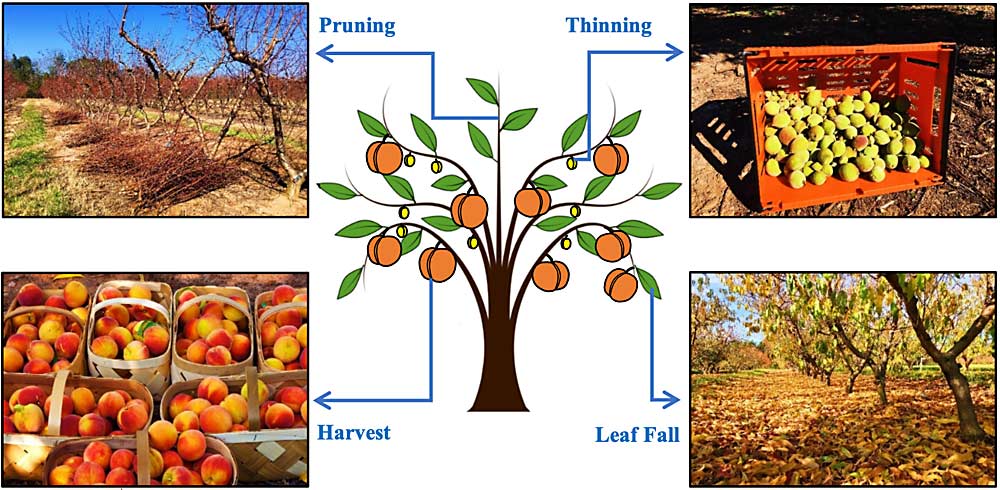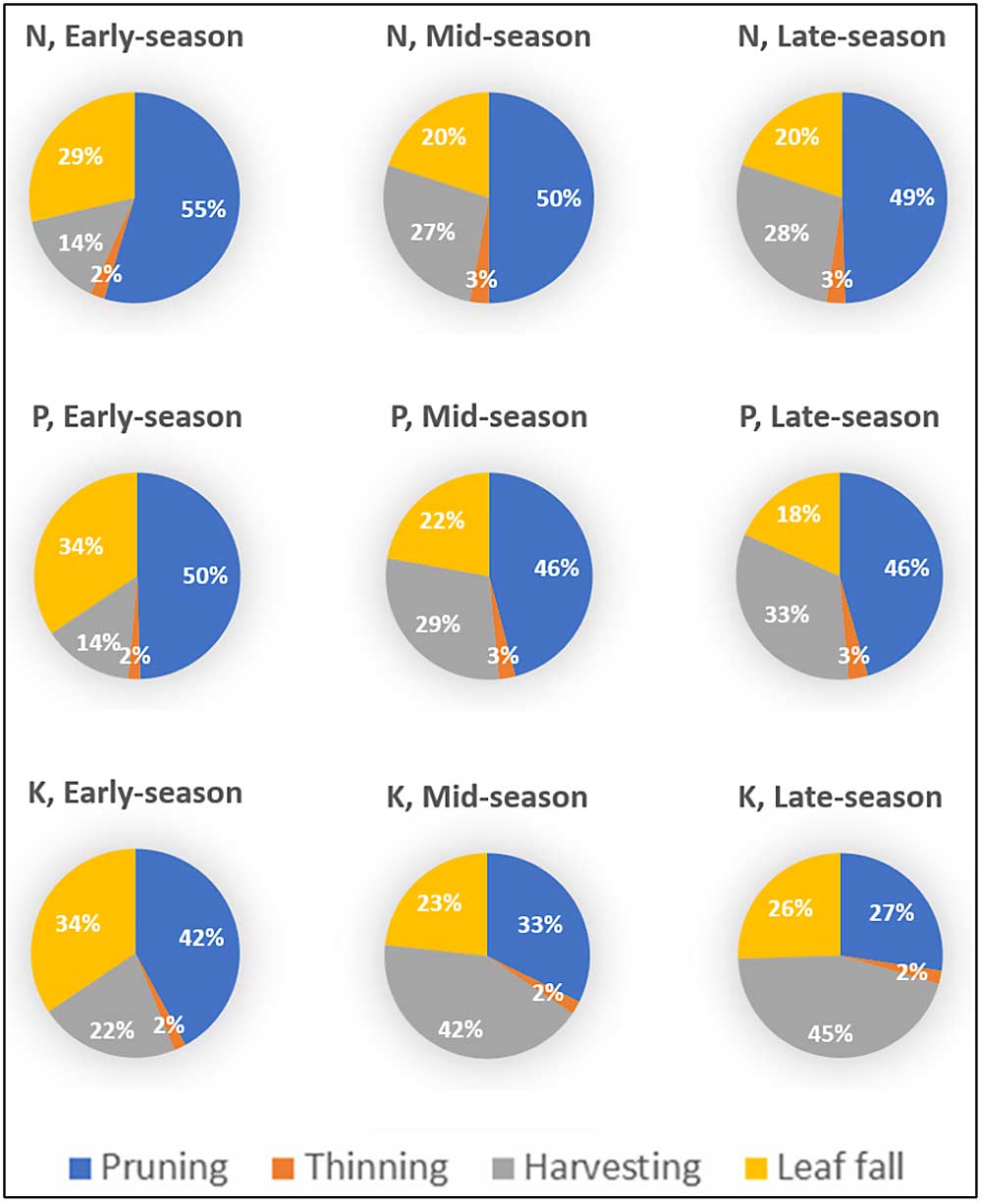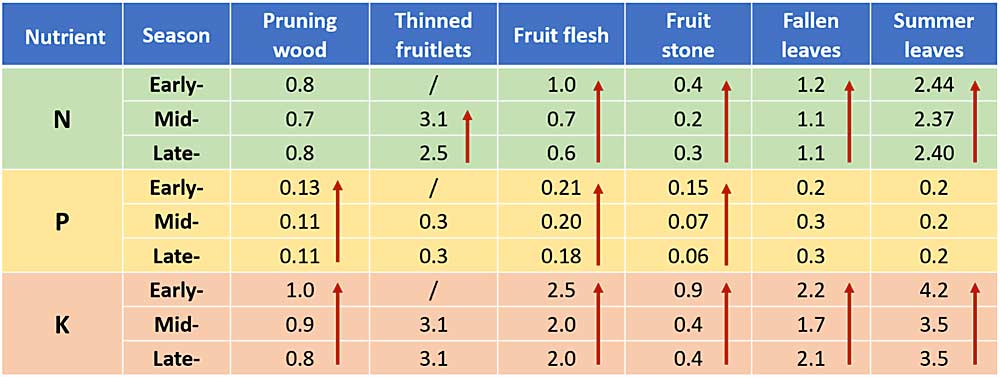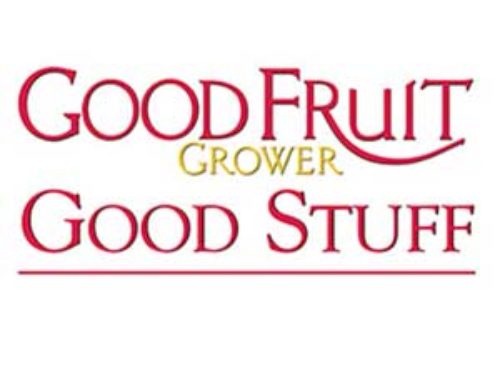
Qi Zhou
A new season is upon growers, and so it’s time to start smart and re-evaluate your fertilization plan to make sure your trees will receive adequate and balanced fertilizer supply to optimize growth, fruit yield and quality.
Nutrient deficiencies not only decrease the fruit yield and plant defense, but also reduce fruit quality. For instance, a low rate of nitrogen fertilization could decrease the citric acid, malic acid and sugar content in peach fruit, which reduces fruit flavor and quality.
However, current fertilization practices in commercial orchards often lead to excessive applications due to overestimation of tree needs.
Excessive nutrient supply may cause luxuriant vegetative growth that leads to internal canopy shading and reduced flower bud production for next year’s crop.

Juan Carlos Melgar
Furthermore, shading negatively affects the color development of fruit and ultimately reduces fruit quality.
Thus, rational applications of fertilizers will help to improve tree health, fruit yield and quality and also to develop a sustainable farm system.
Good orchard nutrition management starts with knowing the requirements of your trees. Estimating the nutrient demands of your trees will provide you with key fertilization information needed for a successful orchard.
Conventionally, nutrient needs of fruit trees are estimated based on yield from the previous year, the production forecast and annual tissue analyses.
Other factors such as nutrient content in tissues removed from the tree system (pruned wood, thinned fruitlets, harvested fruit and abscised leaves, see Figure 1), and the eventual reincorporation of these nutrients into the tree-soil system are seldom considered but should be taken into account for this estimation.

Figure 1: Major events where nutrients are being removed from the tree. (Courtesy Qi Zhou and Juan Carlos Melgar)
Peach cultivars have a relatively short ripening/harvesting window (generally 10 to 14 days), and short storage and shelf-life potential. Thus, multiple cultivars are needed to provide fresh marketable peach fruit throughout the season.
This has led to efforts by breeders, growers and researchers to develop many early- to late-maturing cultivars with different chill requirements (depending on the growing area) and fruit characteristics to lengthen and diversify the production season.
Currently, the peach season can extend from April to September in the northern hemisphere and from October to March in the southern hemisphere.
In the Southeastern United States, peach cultivars are classified as early-season (May to mid-June), mid-season (mid-June to mid-August) and late-season (mid-August to September) based on the fruit ripening date.
Several facts indicate that nutrient demands for peach trees can be affected by different ripening seasons.
For instance, during the growing season, fruit and leaves act as sinks for mineral nutrients; thus, removing the fruit at harvest could alter the sink-source relationship and possibly affect nutrient concentrations or nutrient allocation.
Besides, the presence of fruit on the tree could enhance photosynthetic rates (with an increased sink demand for photo-assimilates) and removing fruit from the tree could accelerate leaf senescence.
The period (length) of leaf senescence in trees could also affect nutrient withdrawal efficiency, with an extended senescence resulting in more nutrient translocation to the reserves before dormancy, which are of critical importance for vegetative and reproductive growth at the beginning of spring the following year.
Thus, we considered it of utmost importance to study the nutrient concentration, allocation and fertilizer demands for early-, mid- and late-season peach trees and to improve peach orchard fertilization.
What we did
We conducted several peach tree nutrient research studies based on the hypothesis that cultivars harvested early in the season could have different nutrient concentrations in the tissues removed from the tree throughout the year, as compared to those harvested later in the season.
We selected 18 mature peach trees (6 years old) of six cultivars. The cultivar/rootstock combinations were:
—Early-season (harvested at the end of May): Spring Snow on Tennessee Natural rootstock and Desiree on Lovell rootstock.
—Mid-season (harvested in July): Sweet N Up on Tennessee Natural and Coralstar on Lovell.
—Late-season (harvested in late August): Snow King on Tennessee Natural and Snow Gem on Lovell.
All trees were grown in a perpendicular V training system and planting space was 1.5 meters by 6 meters.
We collected three years of field data and measured the nutrient concentration in pruned wood, thinned fruitlets, harvested fruit and leaves fallen in autumn (See Figure 1).
We calculated the total amount of nutrients lost at each of these events and compared the nutrient allocation patterns between peach trees with different ripening seasons (See Figure 2).

Figure 2: Nutrient partitioned to each event in different ripening season peach trees. (Courtesy Qi Zhou and Juan Carlos Melgar)
Trees were pruned every year at the beginning of February before bud break. Fruit thinning was carried out manually at the beginning of April (when fruitlets had an approximate diameter of 30 millimeters).
For collecting leaves fallen in autumn, each tree was covered by a mosquito net from September to December. We also monitored and compared the nutrient movement patterns of early-, mid- and late-season peach trees by conducting leaf analysis weekly from the period of postharvest to before leaf senescence.
What we found and our recommendations to growers
The results showed that under the same fertilization rate, early-season peach trees had higher nutrient concentrations compared to mid- and late-season peach trees in all the nutrient removal organs (See Table 1).

Table 1: N, P and K concentrations (percent of dry weight) in organs removed from early-, mid- and late-season peach trees (data collected in 2015). (Courtesy Qi Zhou and Juan Carlos Melgar)
Early-season peach trees are capable of accumulating and mobilizing more nutrients back to the branches, trunks and roots during the period between postharvest and leaf fall. This suggested that in early spring, early-season peach trees had a higher amount of nutrient reserves in perennial structures compared to mid- and late-season peach trees.
Nutrient reserves and nutrient remobilization are especially important for hysteranthous fruit trees (such as peach, apricot and cherry) as leaves unfold following bloom and fruit set, while nutrients for growing tissues (flowers, new shoots and leaves) are required but not supplied by root uptake from the soil until a month after bloom.
Besides, the temperature of air rises faster than the soil in the early spring and, as a consequence, bud burst and flush growth occurs while the soil still has slow rates of nutrient mineralization and low nutrient availability.
Hence, the amount of nutrient reserves in perennial organs and the remobilization of these nutrients are two determining factors for the quality of spring growth for peach trees.
Especially critical to spring growth is nitrogen, with more than 70 percent of reserves remobilized from the trunk, branches and roots to support new shoot and leaf growth in the spring.
Higher amounts of nutrient reserves in early-season peach trees indicates that they might need less fertilization compared to mid- and late-season peach trees.
Early-season cultivars had more dry weight of pruned wood and fallen leaves but less fruit yield (See Table 2).

Table 2: Annually removed dry weight (kg tree-1) through nutrient removal event for early-, mid- and late-season peach trees (average of three years). (Courtesy Qi Zhou and Juan Carlos Melgar)
Under the same fertilization conditions, early-season peach trees had more nutrients removed from pruning and leaf fall, but fewer nutrients removed through harvesting (See Figure 2).
Excessive fertilization often causes a rapid rate of initiation of successive leaf primordia and, hence, promotes vegetative growth. Higher tree vigor, shading and subsequent low photosynthetic activity in trees with luxuriant vegetative growth could reduce the induction of flowers in vegetative buds, and therefore reduce the yield potential.
In order to keep a good balance between vegetative growth and yield, early-season peach trees might need less fertilization than what they have normally received.
We are still working on improving estimations of nutrient requirements for peach trees from different ripening seasons, as part of the nutrients removed through some of these events could return to the soil-tree system (through pruning, thinning and leaf fall).
Preliminary results, however, suggest that farmers need to fertilize differently according to what kind of cultivars they grow, and a specific fertilization strategy that considers different ripening seasons should be used instead of a uniform and calendar-based fertilization plan. •
—by Qi Zhou and Juan Carlos Melgar
Qi Zhou is a Ph.D. candidate in plant and environmental sciences, and Juan Carlos Melgar, Ph.D., is an assistant professor of pomology, both at Clemson University in Clemson, South Carolina.






Excelente análisis, gracias por ello, mismo caso ocurre en las diferentes especies de temprana, media y tardía estación. En cerezas y uvas se nota claramente el déficit o superávit de fertilización.
Very good information’s about NPK content. “Hard to find this kind of information’s, clear with good graphics and easy to understand” but it will be great if provide also NPK removal also.